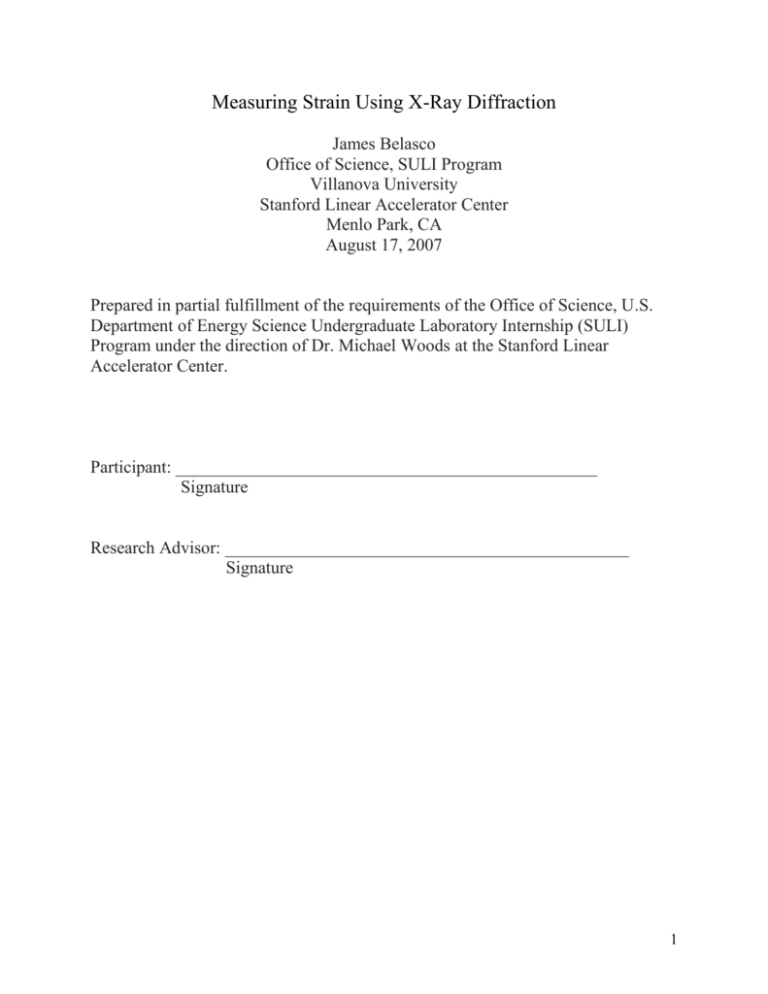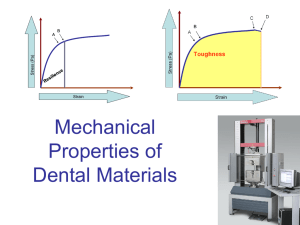Measuring Strain Using X-Ray Diffraction
advertisement

Measuring Strain Using X-Ray Diffraction James Belasco Office of Science, SULI Program Villanova University Stanford Linear Accelerator Center Menlo Park, CA August 17, 2007 Prepared in partial fulfillment of the requirements of the Office of Science, U.S. Department of Energy Science Undergraduate Laboratory Internship (SULI) Program under the direction of Dr. Michael Woods at the Stanford Linear Accelerator Center. Participant: ________________________________________________ Signature Research Advisor: ______________________________________________ Signature 1 Table of Contents Abstract ............................................................................................................................... 3 Introduction ......................................................................................................................... 3 Materials and Methods ........................................................................................................ 5 Results ................................................................................................................................. 7 Discussion ........................................................................................................................... 7 Acknowledgements ............................................................................................................. 9 References ......................................................................................................................... 10 2 Abstract Measuring Strain Using X-Ray Diffraction. JAMES BELASCO (Villanova University, Villanova, PA, 19085) APURVA MEHTA (Stanford Linear Accelerator Center, Menlo Park, CA, 94025) Determining the strain in a material has often been a crucial component in determining the mechanical behavior and integrity of a structural component. While continuum mechanics provides a foundation for dealing with strain on the bulk scale, how a material responds to strain at the very local level—the understanding of which is fundamental to the development of a cohesive framework for the behavior of strained material—is still not well understood. One of the critical components in determination of the behavior of materials under strain at a local scale is an understanding how global average deformation, as a response to an externally applied load, gets distributed locally. This is critical and very poorly understood for a polycrystalline materials—the material of choice for a large variety of structural components. We studied this problem for BCC iron using x-ray diffraction. By using a nanocrystalline iron sample and taking x-ray diffraction patterns at different load levels and at different rotation angles, a complete 2nd rank strain tensor was determined for the three sets of crystallites with three distinct crystallographic orientations. The determination of the strain tensors subsequently allowed the calculation of the elastic modulus along each crystallographic plane. When compared to measured values from single crystal for the corresponding crystal orientations, the data from our polycrystalline sample demonstrated a higher degree of correlation to the single crystal data than expected. The crystallographic planes demonstrated a high degree of anisotropy, and therefore, to maintain displacement continuity, there must be a secondary mode of strain accommodation in a regime that is conventionally thought to be purely elastic. Introduction 3 Every successful major bridge builder elastic, or reversible strain, produce two for half a century has used continuum different types of perturbations in the mechanics to analyze the response of lattice structure of a material. Elastic materials to strain. However, while strain causes a stretching in the lattice continuum mechanics can model the bonds while plastic strain results in deformation of materials at large scales, dislocation and motion of slip-bands. at the very local scale materials The ideal method for measuring such invariably deform and fail, (even in large changes is X-ray diffraction, which structures failure is often initiated by a produces a distinctly different pattern for single crack). At the very local scale, the two different types of strains. Elastic materials are not the homogeneous and strain, which is the primary focus of this isotropic structures continuum paper, alters the spacing of the mechanics assumes them to be, but crystalline lattice and therefore results in instead are composed of an anisotropic shifting of the diffraction peaks [2]. arrangement of discreet atoms and Thus, as a sample is strained along a molecules. Thus, a more complete particular axis, X-ray diffraction patterns understanding of mechanical behavior is can be taken that will elucidate the necessary to reconcile the discrepancy deformation in the lattice structure. between the two views of the behavior Using BCC iron, a ring pattern can be of materials as they are subjected to obtained that can be mathematically stress. analyzed to generate the full second The two types of strain, classified as plastic, or irreversible strain, and order strain tensor. These tensors thereby indicate the particular deformation of the 4 sample under strain as it responds along the amount of out of plane strain in the multiple axes. By calculating the strain material tensors for each of the three diffraction Data collection Procedure rings of iron, the (110), (200), and (211), X-ray diffraction patterns (see Figure 1) (each of which corresponds to a different were taken with a set wavelength of crystallographic orientation) and 0.975 Å as the prepared iron samples comparing them to one another the were rotated from 0 degrees to + 45 deformation of the crystallites with those degrees with a diffraction pattern taken crystallographic orientations can be every 9 degrees. To study the elastic determined. Ultimately, the elastic deformation, the sample was strained to modulus of each lattice plane can be the onset of plastic deformation (the calculated through an analysis of the plastic strain limit taken to be that change in the strain level for increasing determined by traditional continuum load levels. mechanics sources) and the diffraction Materials and Methods patterns were taken at set intervals as the Sample Preparation sample was unloaded, to ensure that at BCC iron samples with a least under conventional mechanics thickness of 13.5 microns were prepared model the subsequent deformation is for x-ray diffraction by cutting them into purely elastic. Patterns were taken at five dog bone shapes that were then inserted separate load levels as well as at the into a displacement controlled tensile initial zero load level. rig. The dog bone shape is used to Pattern Analysis facilitate purely tensile loading and limit 5 An unstrained lattice produces a Strain Tensor Determination diffraction pattern with circular rings. The change in ellipticity of a diffraction When a sample is under elastic tensile ring under load is seen as a noticeable stress, the lattice spacing elongates in the fluctuation (termed “wiggle”) in the direction of the applied load and normally straight line of the Q vs. chi contracts in the orthogonal directions. polar plot (see Figure 2). Using a This results in an elliptical distortion of program developed in MATLAB®, a the diffraction rings. The eccentricity of Gaussian fit was used to determine the these ellipses directly corresponds to location of the high intensity points of how the sample has deformed under the wiggle (Figure 3), the magnitude of strain. In order to analyze the nature of the intensity, and the width of the this ellipse, the 2-D diffraction images intensity curve. The resulting Q and chi were converted to diffraction coordinates coordinates of the intensity peaks were (Q, chi) from pixel positions using then transformed into the psi and phi Fit2D. Fit2D itself was calibrated for coordinates used in the standard sin2 specific measurements using LaB6 technique [1]. These calculated values samples that have standardized were then used to generate the diffraction parameters. The eccentricity coefficients for the strain tensors of the ellipse and the resulting equation according to: magnitude of all the six independent 11 cos2 sin 2 22 sin 2 sin 2 33 cos2 components of the 2nd rank strain tensor 12 sin 2 sin 2 23 sin sin 2 13 cos sin 2 (1) were determined from this converted data by the procedure outlined below. Where: d d 0 d0 (2) 6 And the change in d is the displacement Figure 4. Assuming the elastic of the sample as it stretches under strain. deformation is linear with stress and For each load level, the MATLAB® strain, a linear fit of the strain data was program takes data from all the taken for each ring. The slope of this fit diffraction patterns as output by Fit2D provided the elastic modulus along each and then uses the collective data points crystallographic direction. from each strain level in a least-squares The theoretical values for the elastic fit, weighted by widths provided by the modulus along each of the intensity curves, to solve for the second crystallographic planes of the BCC iron order strain tensors (εij) as well as were calculated using: generate the error values for each 1 2 s11 2[( s11 s12 ) 12 s 44 ](l12 l 22 l 22 l32 l12 l31 ) E calculated tensor. This process was then (4) repeated for each of the three diffraction Where l1, l2, l3 are the direction cosines rings produced by BCC iron. for the particular lattice plane as given in Results Table 1, and the s values are the stiffness The strain tensor data for each ring at constants specific to a given material, each load level was tabulated (see Table shown in Table 2 for iron. 4,5,6) and for each ring the calculated These values are compared to the single strain tensor in the ε22 direction (the load crystal values for the elastic modulus in axis of the dog bone sample which will the chosen crystallographic directions in demonstrate the most dramatic stain) Table 3. was plotted in Origin against the stress at each load level as demonstrated in Discussion 7 The tabulated values for the strain tensor (d0). The data was manually shifted data demonstrate what is expected in closer to the origin to compensate for the terms of sample deformation along inaccurate estimation of d0 values. particular axes. As the strain increases in Ideally the actual d0 value could be the ε22 direction, the strain values in the determined by analyzing calibration ε33 become negative as would be parameters. In any case, the shifted data expected from a material elongating in does not impact the calculation of the one direction while contracting in the elastic modulus for the different lattice other direction. directions. The data as plotted in the ε22 graph The measured values for the elastic produces a pretty good linear fit, modulus along the three crystallographic providing credible elastic modulus directions are surprisingly dissimilar values along the different from each other, and similar to the single crystallographic directions. The error crystal values. In fact, the measured bars on the individual points, while value for the (211) plane is exceptionally present, are too small to be noticeable close to the single crystal value. Rather demonstrating a high confidence in the than exhibiting the behavior expected by method developed for obtaining strain continuum mechanics—including the from 2D diffraction pattern. However, averaging out of strain values as the the plotted ε22 data sets and fitted lines material was stretched—such a do not have intercepts at zero because correlation indicates that in the their location on the y-axis depends on polycrystalline sample used the strain is the particular unstrained lattice spacing distributed along the different 8 crystallographic directions in highly distribute strain to accommodate the anisotropic manner. Thus, although the anisotropy observed here while still sample is polycrystalline, the high demonstrating elasticity. anisotropy of the crystallographic Acknowledgements orientations of iron has a large effect as This project was performed at the the sample reacts to stress. Stanford Linear Accelerator Center in Such a conclusion is problematic Palo Alto, California. I would like to because this high anisotropy would seem thank the U.S. Department of Energy for to indicate that the crystalline structure providing the funding and facilities for would deform differently in the same the Summer Undergraduate Laboratory direction depending on crystallographic Internship (SULI) program in which I orientation resulting in discontinuities was allowed to participate. I would also between grains in the material, if they like to thank my mentor, Apurva Mehta, are not accommodated by a secondary for his guidance, support, and expertise mode of strain distribution. But the as well as David Bronfenbrenner who loading procedure utilized is supposed to worked with me throughout this project. result in purely elastic – single mode deformation. Certainly continuum mechanics is proven on a larger scale, and the degree of anisotropy demonstrated indicates that more research must be done to determine by what mechanism crystalline structures 9 References [1] I.C. Noyan, J.B Cohen. Residual [3] Viktor Hauk. Structural and Residual Stress Analysis by Stress: Measurement by Nondestructive Methods. New Diffraction and Interpretation. York: Elsevier, 1997. pp. 135- New York: Springer-Verlag, 150 1987, pp. 117-120 [2] B.E. Warren. X-Ray Diffraction. [4] Richard W. Hertzberg. Deformation and Fracture New York: Dover Publications, Mechanics of Engineering 1969, pp. 102-115 Materials. New York: Wiley, 1995. pp.10-16. Figure 1. Diffraction pattern for BCC iron highlighting the three analyzed rings. 10 Figure 2. Results of Fit2D coordinate transformation of diffraction pattern to Q/chi space. a) the transformed pattern of an unstrained sample b) the pattern from a strained sample 2 3 Figure 4. Stress-strain plot for each crystallographic plane along the principle loading direction. 4 5








